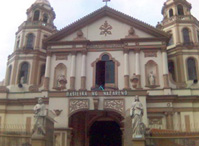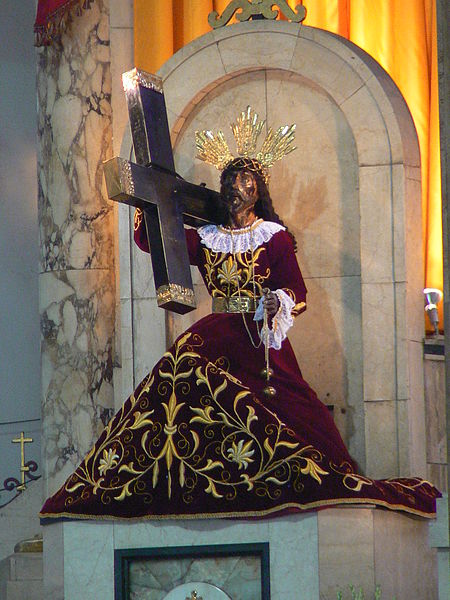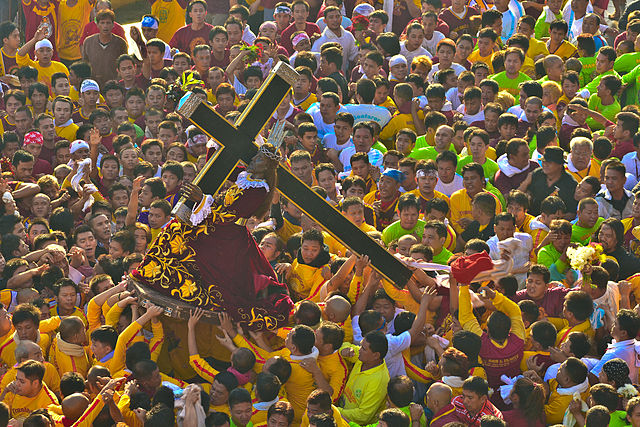Fabulous Philippines > Manila > Quiapo Church, Manila
Quiapo Church
Manila
Share this page:
The Quiapo Church (known more formally as the "Minor Basilica of the Black Nazarene" or "Saint John the Baptist Church", and, in Tagalog, as the "Basilika ng Nazareno") is located in the Manila suburb of Quiapo.

Quiapo Church
The church houses a large dark life-sized sculpture of Christ bearing the cross -- called the "Black Nazarene" (or, in Spanish, "Nuestro Padre Jesús Nazareno de Quiapo" and in Tagalog as "Poong Itim na Nazareno").
This sculpture was carved in Mexico in the early 1600s, was brought out to the Philippines from Mexico by Spanish galleon and was finally placed in the Quiapo Church in the late 1700s. It is said by the faithful to have miraculous powers.
On Fridays thousands of Catholic devotees may be seen inside the church edging forward on their knees towards the crucifix, praying for a favor, for a miracle or for forgiveness.
Around the church is an outdoor market catering to all sorts of needs from the spiritual to the mundane – everything from fortune telling, faith healing, balloons, flowers, candles, incense, lotions, oils, figurines, icons, statuettes, talismans, rosaries, and herbal products, to bargains handicrafts and very cheap (and often pirated) DVDs, CDs, software, jewelery, and electronics.
The whole scene is one in which the religiosity of the Filipinos can be seen.

The Statue of the Black Nazarene
Photo: Constantine Agustin.
What Does the Black Nazarene Look Like?
• The sculpture of Christ is 5' 5" high.
• It is dressed in an embroidered and lace-trimmed velvet maroon tunic.
• It has a gold-plated waist belt embossed with the word NAZARENO.
• Its left hand carries a gold chain and ball loops.
• The statue stands in a genuflecting (kneeling) posture and carries a 6' 0" high wooden cross.
• The material of the sculpture is either wood or ivory (depending on the authority you are consulting)
Why the Black Nazarene?
According to tradition, during the wooden sculpture's voyage out from Mexico to the Philippines by Spanish galleon, the ship caught fire and as a result the surface of the sculpture was charred to a dark colour, which gave it the name of the "Black Nazarene".
Interestingly the sculpture (or at least part of it -- most authorities say that only the head of the sculpture we have is original and the body is a replica) has managed to survive a number of other disasters since then, including large fires in the Quiapo area in 1791 and 1929, earthquakes in 1863 and 1899, and finally the carpet bombing during the Battle of Manila in World War II.
The Feast of the Black Nazarene
In January every year a week long festival (the Feast of the Black Nazarene) takes place. It culminates on January 9 when an immense solemn procession (known in Spanish as a traslación) takes place during which the sculpture of the Black Nazarene (affectionately known as El Señor) is "translated" (carried along) from Quiapo Church to the Church of St Nicholas Tolentino.
The Black Nazarene is surrounded en route by millions of faithful (police estimated the crowd at 9 million in January 2013), many of whom are barefooted and many of whom try to touch it and gain a blessing or a miracle.

The Feast of the Black Nazarene
Photo: Jsinglador.
History
In 1586 the Franciscan order of the Roman Catholic church built the first Quiapo Church on the same site as where we see today's church of the same name. It was constructed using a frame bamboo and thatching out of nipa palm. This church was burnt down in 1639.
A second Quiapo Church was built on the same site. though the building was stronger, it was destroyed in the powerful 1863 earthquake.
A third Quiapo Church was built, with construction being completed in 1899, only to be almost completed destroyed by fire just decades later – in 1928.
The fourth (and current) Quiapo Church was then built in the Mexican Baroque style. A second belfry and a dome were added to the design.
In front of the Church is the Plaza Miranda where political and protest rallies and entertainment events have long been held. On 21 August 1971 a bomb exploded at a rally killing nine people and injuring almost 100. President Marcos was blamed and he in turn blamed the Communists; then shortly thereafter martial law was imposed.
Share this page:
Author: David Paul Wagner
(David Paul Wagner on Google+)
|